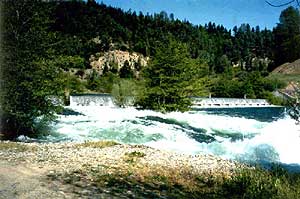Recommended Trinity River Release Schedule for Water Year 2004
by Doug Schleusner, Executive Director,
Trinity River Restoration Program
 |
Spring Releases (6000 cfs) in May 2002
Scientific studies conducted over the last 10 years on the Trinity River show that re-establishing a more natural hydrograph that varies from year to year is important to the success of the on-going restoration efforts. Variable flows of sufficient size can clean spawning gravels, build gravel/cobble bars, scour sand out of pools, provide adequate temperature and habitat conditions for fish and wildlife at different life stages, control riparian vegetation, and perform many other ecological functions. The basic intent of a flow schedule is to mimic the snow melt pattern of a given water year type. This means that flows (releases from Lewiston Dam) generally start to increase near the end of April and last from 1 to 3 months before ramping down to summer base levels.
Each year the U.S. Bureau of Reclamation determines the water year type for the Trinity River based on the amount of water that has flowed into Trinity Lake from October 1 to April 1, and the additional amount of water expected from rainfall and snowmelt for the rest of the year (through September 30). On April 7, the final runoff forecast established 2004 as a “wet” water year within the Trinity River basin.
| Water Year Type
| Water Volume for Trinity River
(acre-feet)
|
| Critically Dry
| 369,000
|
| Dry
| 453,000
|
| Normal
| 647,000
|
| Wet
| 701,000
|
| Extremely Wet
| 815,000
|
The Record of Decision (ROD) signed in December 2000 established the following volumes by water year type. In December 2002, a U.S. District Court capped annual releases at dry year volumes (regardless of water year classification) pending completion of a Supplemental Environmental Impact Statement required by litigation, but a recent decision by the Ninth Circuit Court of Appeals allows for the release of the Normal Year flows this spring.
The Trinity River Restoration Program staff, also established in the December 2000 ROD, has the responsibility of developing the annual instream fisheries release schedule for Lewiston Dam. The Trinity River Flow Evaluation Study (TRFES) provides the scientific basis for scheduling the variable annual instream flows, including specific, measurable flow related restoration objectives and annual hydrographs by water year type. Staff recommendations also incorporate advice from technical representatives of the Trinity Management Council (TMC) and Trinity Adaptive Management Working Group (TAMWG). Specifically, these scientists and resource specialists agree that this year’s restoration priorities should be:
- Complete scheduled bridge replacements,
- Maximize Chinook smolt production by providing optimal rearing temperatures throughout the mainstem river system, and
- Achieve substantial geomorphic benefits by flushing large accumulations of fine sediment that have been deposited over the past two years, move and redeposit gravel, and scour 1-2 year old riparian vegetation that has re-encroached along the channel’s edge, all of which will improve habitat conditions throughout the system.
The recommended release schedule will achieve these objectives. Lewiston Dam releases will begin to increase on May 4th from 300 cfs to 6,000 cfs on May16th and continue at that level until May 25th. The flows will then ramp down to 2,000 cfs by June 18th and hold at that level, until about July 9, finally reaching the summer base flows of 450 cfs on July22. This represents a total volume of 647,000 acre-feet compared to 453,000 acre-feet released last year.
The bridge construction schedule is being modified to accommodate the recommended releases. The primary effect on the construction schedule is that instream work cannot commence before mid-July 2004, resulting in a completion date of November 15 rather than September 15. Even so, bridges will be capable of passing higher flows in 2005 if allowed by the courts.
This year’s release schedule was reviewed by the Trinity Management Council (TMC) on April 14 and again the week of April 26th. After it was approved, it was forwarded to the Bureau of Reclamation’s Central Valley Operations Office, which will operate the Trinity River Division as closely to the proposed schedule as technically feasible. The daily release schedule is available on the Reclamation’s website at: www.mp.usbr.gov/cvo/.
The figure below illustrates the release schedule for the available 647,000 acre-feet of water.
This issue of the Conservation Almanac is funded in part by grants from the
Trinity River Restoration Program and the California Fire Safe Council
|


